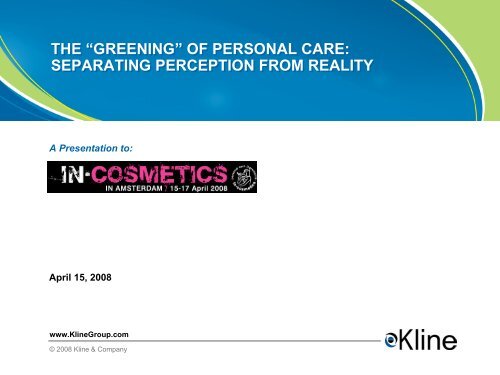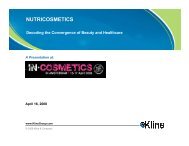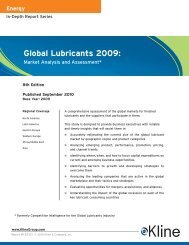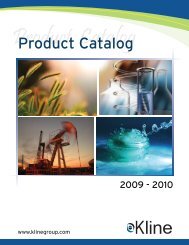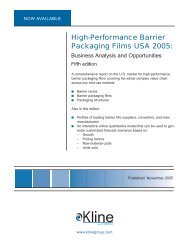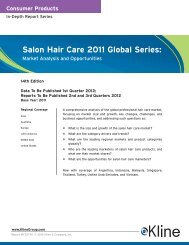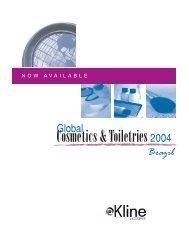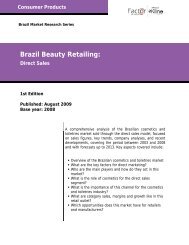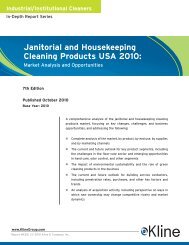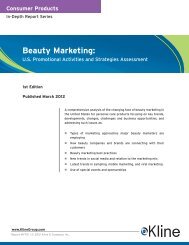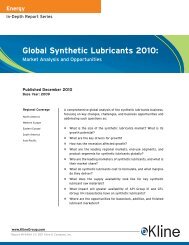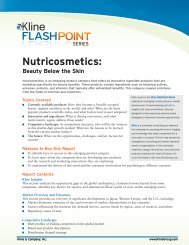"Greening" of Personal Care - Kline & Company
"Greening" of Personal Care - Kline & Company
"Greening" of Personal Care - Kline & Company
Create successful ePaper yourself
Turn your PDF publications into a flip-book with our unique Google optimized e-Paper software.
THE “GREENING” OF PERSONAL CARE:<br />
SEPARATING PERCEPTION FROM REALITY<br />
A Presentation to:<br />
April 15, 2008<br />
www.<strong>Kline</strong>Group.com<br />
© 2008 <strong>Kline</strong> & <strong>Company</strong>
Agenda<br />
Overview <strong>of</strong> <strong>Kline</strong> & <strong>Company</strong><br />
Key Drivers for Natural/Green <strong>Personal</strong> <strong>Care</strong><br />
What Does Natural/Green Mean?<br />
Green <strong>Personal</strong> <strong>Care</strong> Ingredients<br />
Outlook<br />
© 2008 <strong>Kline</strong> & <strong>Company</strong><br />
1
Agenda<br />
Overview <strong>of</strong> <strong>Kline</strong> & <strong>Company</strong><br />
Key Drivers for Natural/Green <strong>Personal</strong> <strong>Care</strong><br />
What Does Natural/Green Mean?<br />
Green <strong>Personal</strong> <strong>Care</strong> Ingredients<br />
Outlook<br />
© 2008 <strong>Kline</strong> & <strong>Company</strong><br />
2
<strong>Kline</strong> & <strong>Company</strong> is a leading management consulting and market research<br />
firm with domain expertise across the personal care value chain.<br />
<strong>Kline</strong><br />
Management<br />
Consulting<br />
Working with individual<br />
clients to resolve tough<br />
issues and help<br />
implement solutions<br />
Managed flow <strong>of</strong><br />
people, ideas and<br />
data<br />
© 2008 <strong>Kline</strong> & <strong>Company</strong><br />
<strong>Kline</strong> Market<br />
Research<br />
Generating information<br />
and insights for multiple<br />
clients through<br />
syndicated research<br />
3
<strong>Kline</strong> Management Consulting combines industry expertise with world<br />
class service delivery.<br />
Consulting Services<br />
Strategy<br />
Technology<br />
Manufacturing &<br />
Supply Chain<br />
Customer<br />
Relationships<br />
Energy<br />
<strong>Kline</strong><br />
Management<br />
Consulting<br />
Industry Practices<br />
Chemicals<br />
& Materials<br />
© 2008 <strong>Kline</strong> & <strong>Company</strong><br />
Life<br />
Sciences<br />
Consumer<br />
Products<br />
4
Our personal care domain expertise covers the whole value chain<br />
RAW<br />
MATERIALS<br />
� Antimicrobials<br />
� Conditioning polymers<br />
� Emollients<br />
� Hair fixative polymers<br />
� Rheology control<br />
agents<br />
� Skin whitening agents<br />
� Specialty actives<br />
� Specialty delivery<br />
systems<br />
� Specialty surfactants<br />
� UV absorbers<br />
FINISHED<br />
GOODS<br />
� Fragrances<br />
� Hair care<br />
� Makeup<br />
� Nail care<br />
� Oral care<br />
� Skin care<br />
� Toiletries<br />
© 2008 <strong>Kline</strong> & <strong>Company</strong><br />
RETAIL<br />
OUTLETS<br />
� Department stores<br />
� Direct sales<br />
� Drug outlets<br />
� Food stores<br />
� Mass merchandisers<br />
� Pharmacies/<br />
perfumeries<br />
� Salons<br />
� Spas/beauty institutes<br />
� Specialty stores<br />
5
We Serve Clients Around The Globe<br />
We can handle local research engagements or global assignments<br />
� Global Headquarters<br />
– Little Falls, NJ<br />
� <strong>Kline</strong> Europe<br />
– Brussels, Belgium<br />
– Oxford, United Kingdom<br />
– Prague, Czech Republic<br />
– Milan, Italy<br />
� <strong>Kline</strong> Asia<br />
– Shanghai, China<br />
– Tokyo, Japan<br />
– New Delhi, India<br />
– Dubai, UAE<br />
� <strong>Kline</strong> Latin America<br />
– São Paulo, Brazil<br />
© 2008 <strong>Kline</strong> & <strong>Company</strong><br />
6
Agenda<br />
Overview <strong>of</strong> <strong>Kline</strong> & <strong>Company</strong><br />
Key Drivers for Natural/Green <strong>Personal</strong> <strong>Care</strong><br />
What Does Natural/Green Mean?<br />
Green <strong>Personal</strong> <strong>Care</strong> Ingredients<br />
Outlook<br />
© 2008 <strong>Kline</strong> & <strong>Company</strong><br />
7
Fashion<br />
Ingredients<br />
Functionality<br />
Evolution <strong>of</strong> personal care industry<br />
Competitive<br />
landscape<br />
Pigments, dyes, natural oils, “soaps” Surfactants, uv absorbers, polymers, antimicrobials<br />
Natural Synthetic<br />
Decoration<br />
© 2008 <strong>Kline</strong> & <strong>Company</strong><br />
Performance<br />
Natural/green<br />
Emergence <strong>of</strong> leading brand owners<br />
8
Key growth drivers for natural personal care<br />
9<br />
Widespread<br />
concern about<br />
toxic ingredients<br />
Consumer<br />
awareness<br />
Greater supply<br />
<strong>of</strong> natural<br />
ingredients<br />
© 2008 <strong>Kline</strong> & <strong>Company</strong><br />
Media hype<br />
celebrities/<br />
politicians<br />
Marketers<br />
staking<br />
a claim<br />
9
The environment is increasingly part <strong>of</strong> our conscience.<br />
10<br />
© 2008 <strong>Kline</strong> & <strong>Company</strong><br />
10
Major marketers are taking notice via key acquisitions.<br />
11<br />
� Kiehl’s (2000)<br />
� The Body Shop (2006)<br />
� San<strong>of</strong>lore (2006)<br />
� Tom’s <strong>of</strong> Maine (2006)<br />
) � Aveda (1997)<br />
)<br />
© 2008 <strong>Kline</strong> & <strong>Company</strong><br />
� Bumble and bumble (2000)<br />
� Darphin (2003)<br />
� Ojon (2007)<br />
� Burt’s Bees (2007)<br />
11
Agenda<br />
Overview <strong>of</strong> <strong>Kline</strong> & <strong>Company</strong><br />
Key Drivers for Natural/Green <strong>Personal</strong> <strong>Care</strong><br />
What Does Natural/Green Mean?<br />
Green <strong>Personal</strong> <strong>Care</strong> Ingredients<br />
Outlook<br />
© 2008 <strong>Kline</strong> & <strong>Company</strong><br />
12
Today, natural personal care products represent a small, high-growth<br />
segment <strong>of</strong> the overall global personal care market.<br />
<strong>Personal</strong> <strong>Care</strong> Sales by Sector Growth<br />
Natural, 2%<br />
$180 billion manufacturers’ sales level<br />
Natural<br />
Overall<br />
market<br />
© 2008 <strong>Kline</strong> & <strong>Company</strong><br />
0 5 10 15<br />
13
In a recently published market research report, <strong>Kline</strong> assessed 26 “natural”<br />
cosmetic and toiletry brands with sales ranging from $2 million to > $500<br />
million.<br />
14<br />
� Alba � Dr. Hauschka<br />
� Aubrey Organics � Lavera<br />
� Arbonne � L’Occitane<br />
� Avalon Natural Products � Lush<br />
� Aveda (Estee Lauder) � Nature’s Gate<br />
� Burt’s Bees � Organix<br />
� <strong>Care</strong> by Stella McCartney � Primavera<br />
� Jason Natural Products � Pangea Organics<br />
� John Masters Organics � The Body Shop (L’Oreal)<br />
� Jurlique � Tom’s <strong>of</strong> Maine (Colgate-Palmolive)<br />
� Kiss My Face � San<strong>of</strong>lore (L'Oreal)<br />
� Kneipp � Weleda<br />
� Korres Natural Products � Zia Natural<br />
© 2008 <strong>Kline</strong> & <strong>Company</strong><br />
14
Contained within each brand’s overall pr<strong>of</strong>ile, is an ingredient analysis and<br />
assessment.<br />
15<br />
� First, a cross-section <strong>of</strong> products were selected from each <strong>of</strong> the 26 brands<br />
that were pr<strong>of</strong>iled in our report<br />
� Where possible, like product categories were chosen across all brands<br />
� Each brand’s pr<strong>of</strong>ile contains the brand’s ingredient analysis and assessment<br />
as well as its overall “natural” rating<br />
−<br />
Sustainability was not part <strong>of</strong> the assessment<br />
� The ingredient assessment was performed by a member <strong>of</strong> our specialty<br />
chemicals practice who also developed our 10 point rating system<br />
© 2008 <strong>Kline</strong> & <strong>Company</strong><br />
15
<strong>Kline</strong>’s 10 point rating system . . .<br />
16<br />
Rating Criteria<br />
1 Majority <strong>of</strong> or all ingredients are synthetic; comparable to<br />
competitive products which are not marketed as “natural”;<br />
virtually no naturals or botanicals<br />
2 Rely on performance ingredients from the full range <strong>of</strong><br />
synthetic raw materials as major ingredients; also use natural<br />
ingredients, <strong>of</strong>ten as minor ingredients<br />
3 Similar to 2 rating but greater emphasis on natural ingredients<br />
and ethics <strong>of</strong> supply chain<br />
(Continued)<br />
© 2008 <strong>Kline</strong> & <strong>Company</strong><br />
16
<strong>Kline</strong>’s 10 point rating system . . . (Continued)<br />
17<br />
Rating Criteria<br />
4 Like 1-3, uses a number <strong>of</strong> non-naturals such as silicones,<br />
synthetic polymers, SLS, ethoxylates, alpha-olefins or other<br />
non-conforming ingredients but high proportion <strong>of</strong> natural and<br />
botanical ingredients<br />
5 Higher proportion <strong>of</strong> natural ingredients than 1-4, but also<br />
uses some less desirable ingredients such as silicones and<br />
polysorbates<br />
6 Leans strongly towards use <strong>of</strong> botanical extracts but also uses<br />
some non-naturals ingredients such as ethoxylates or<br />
chemical derivatives<br />
7 Minor use <strong>of</strong> non-natural ingredients such as UV filters,<br />
emulsifiers, surfactants<br />
(Continued)<br />
© 2008 <strong>Kline</strong> & <strong>Company</strong><br />
17
<strong>Kline</strong>’s 10 point rating system . . . (Continued)<br />
<strong>Kline</strong>’s 10 point rating system . . . (Continued)<br />
18<br />
Rating Criteria<br />
8 High use <strong>of</strong> natural ingredients, limited use <strong>of</strong> non-naturals<br />
such as chemical UV filters when few natural alternatives to<br />
synthetic technology<br />
9 Uses a high proportion <strong>of</strong> natural ingredients or derivatives<br />
which are made using acceptable physical or chemical<br />
processing. In addition to avoiding harsh surfactants, opts for<br />
the mildest and most environmentally friendly alternatives.<br />
10 Many <strong>of</strong> the botanical extracts are from organically farmed<br />
sources. Minor ingredients also considered natural.<br />
© 2008 <strong>Kline</strong> & <strong>Company</strong><br />
18
The most common ingredients that are avoided in natural products are the<br />
following . . .<br />
19<br />
� Parabens—preservatives<br />
� Propylene glycol—moisturizing agents<br />
� Petrolatum—gives emollient properties<br />
� Synthetic oils (mineral oils, isohexadecane,<br />
etc.)<br />
� Organic sunscreens<br />
� Silicones<br />
� Harsh surfactants—sodium lauryl sulfate<br />
© 2008 <strong>Kline</strong> & <strong>Company</strong><br />
19
20<br />
We found that <strong>of</strong> the 26 brand pr<strong>of</strong>iled in our report, the degree <strong>of</strong><br />
“naturalness” ran a broad spectrum<br />
Nature-inspired.<br />
Heavy use <strong>of</strong><br />
synthetics<br />
� �<br />
� � � �<br />
� � � � � � � � �<br />
� � � � � � � � � �<br />
Some use <strong>of</strong><br />
non-naturals<br />
© 2008 <strong>Kline</strong> & <strong>Company</strong><br />
�<br />
Organic,<br />
and green<br />
20
Agenda<br />
Overview <strong>of</strong> <strong>Kline</strong> & <strong>Company</strong><br />
Key Drivers for Natural/Green <strong>Personal</strong> <strong>Care</strong><br />
What Does Natural/Green Mean?<br />
Green <strong>Personal</strong> <strong>Care</strong> Ingredients<br />
Outlook<br />
© 2008 <strong>Kline</strong> & <strong>Company</strong><br />
21
% Of total<br />
<strong>Personal</strong> care ingredients are an $8-10 billion industry, <strong>of</strong> which ~ 30% are<br />
green<br />
50<br />
45<br />
40<br />
35<br />
30<br />
25<br />
20<br />
15<br />
10<br />
5<br />
0<br />
Ingredient Market<br />
Commodities Fine chemicals Specialties<br />
Undifferentiated<br />
% Of total<br />
© 2008 <strong>Kline</strong> & <strong>Company</strong><br />
Ingredient market: Green vs Non-green<br />
breakdown<br />
100<br />
80<br />
60<br />
40<br />
20<br />
0<br />
Green<br />
22
Selected ingredient segments and leading products<br />
Surfactants Emollients Emulsifiers<br />
Fatty alcohol<br />
sulfates<br />
Fatty alcohol<br />
ether sulfates<br />
Mineral oil Fatty acidd and<br />
derivatives<br />
Hair-fixative<br />
polymers<br />
Synthetic oils Sorbitan esters Acrylic<br />
polymers<br />
Anti-microbials Rheology<br />
control agents<br />
© 2008 <strong>Kline</strong> & <strong>Company</strong><br />
Solvents/carrier<br />
s<br />
Conditioning<br />
polymers<br />
Cosmetic<br />
actives<br />
Vinyl polymers Parabens Cellulosics Ethanol Silicones Vitamins<br />
Phenoxyrthanol Silicas Propylene<br />
glycol<br />
Alkanolamides PEG esters Polyesters Ureas Bentonites Guar<br />
derivatives<br />
Betaines Esters Fatty<br />
acid/alcohol<br />
ethoxylates<br />
Sarcosinates Lanolin Ethoxylated<br />
glyceryl esters<br />
Isethionates Natural oils Ethoxylated<br />
sorbitan esters<br />
Polyurethanes Hydantoins Starch<br />
derivatives<br />
Taurates Lecithin Carragennan<br />
Sulfosuccinates Sucrose esters Guar<br />
Alkyl<br />
polyglucosides<br />
Amine oxides<br />
Quats<br />
Polyquats Botanical<br />
extracts<br />
Protein<br />
hydrolysates<br />
Hyaluronic acid<br />
Beta-glucans<br />
Copolymers Pyrithiones Xanthan gum Is<strong>of</strong>lavones<br />
Alginates Synthetic<br />
peptides<br />
Acrylic<br />
polymers<br />
23
24<br />
What makes natural personal care an attractive market to ingredient companies?<br />
Ability to<br />
differentiate and<br />
extract value<br />
Growing<br />
consumer<br />
eco-awareness<br />
Marketing<br />
appeal <strong>of</strong><br />
certification<br />
seal<br />
© 2008 <strong>Kline</strong> & <strong>Company</strong><br />
Business<br />
opportunities<br />
in growing<br />
market<br />
Corporate<br />
social<br />
conscience<br />
24
Natural versus green<br />
� There is a realization amongst brand owners that the natural concept can not be<br />
applied across all personal categories and retail channels<br />
− Natural may not be better for the environment and local economies. Further,<br />
other factors arise when an ingredient is harvested from fragile environments<br />
� For leave-on skin care, a natural formulation can provide a satisfactory level <strong>of</strong><br />
performance for the consumer, but for many other personal care categories,<br />
natural ingredients have performance limitations<br />
© 2008 <strong>Kline</strong> & <strong>Company</strong><br />
25
<strong>Kline</strong>’s guideline definition <strong>of</strong> a ‘green’ ingredient<br />
� Ingredients are from a plant or renewable source<br />
� Some chemical modification acceptable (e.g. hydrolysis, hydrogenation, esterification)<br />
� But some chemical modifications are unacceptable (e.g. ethoxylation)<br />
� Minerals and inorganic materials acceptable<br />
� Ingredients made by fermentation using plant raw materials acceptable<br />
� Organically farmed plant sources not essential<br />
� Animal products are not excluded e.g. silk and milk proteins, beeswax<br />
� Excludes:<br />
− Synthetic ingredients<br />
− Petrochemical derivatives and synthetic solvents<br />
� Preservation considered to a minor extent as preservatives such a small part <strong>of</strong><br />
formulation<br />
� No account made <strong>of</strong>:<br />
− Biodegradability<br />
−<br />
−<br />
−<br />
Farming ethics<br />
Genetic engineering <strong>of</strong> plant source material<br />
Purification methods for natural oils<br />
Based on this definition, we can look more closely at selected personal care ingredient product<br />
categories to see how they contribute to the “greeness” <strong>of</strong> a finished product<br />
© 2008 <strong>Kline</strong> & <strong>Company</strong><br />
26
Hair Fixatives<br />
© 2008 <strong>Kline</strong> & <strong>Company</strong><br />
27
Hair fixative polymers are used singly or combined to provide the<br />
optimal compromise in terms <strong>of</strong> price and performance<br />
Sample Formulation Hair Gel<br />
PVP/VA 12%<br />
Additives ~1%<br />
Aqua to 100%<br />
Sample Formulation Hair Spray<br />
Amphomer 5%<br />
Alcohol 66%<br />
Propane/butane 25%<br />
Other 4%<br />
Aqua to 100%<br />
Sample Formulation Hair Gel Strong Hold<br />
VP/methacrylamide/vinyl imidazole<br />
copolymer<br />
* Based on ‘as sold’ basis<br />
10%<br />
PVP 1%<br />
Other ~4%<br />
Aqua 85%<br />
© 2008 <strong>Kline</strong> & <strong>Company</strong><br />
� Hair fixative polymers give hair styling<br />
products their high level <strong>of</strong> functionality and<br />
performance<br />
� Formulations are fairly simple consisting <strong>of</strong><br />
mainly <strong>of</strong> the resin/fixative polymer(s) in a<br />
carrier<br />
� Sprays contain a high proportion <strong>of</strong> alcohol<br />
and aerosols are propellant based<br />
28
Hair fixative polymer choice is based on several parameters<br />
Decreasing order <strong>of</strong> importance<br />
� Styling performance required<br />
� Film flexibility<br />
� Product type (gel, spray, pomade, etc)<br />
� Trade class<br />
� Lack <strong>of</strong> flakiness<br />
� Water-pro<strong>of</strong>ability<br />
� Low/no odor<br />
� Ease <strong>of</strong> processing<br />
© 2008 <strong>Kline</strong> & <strong>Company</strong><br />
29
Less than 1% <strong>of</strong> the hair fixative polymers used today are green<br />
Monomer Product<br />
Vinyl PVP<br />
PVP/VA<br />
Esters <strong>of</strong> PVM/MA<br />
VA/crotonates/vinyl neodecanoate copolymer<br />
Acrylic Acrylates/octylacrylamide copolymer<br />
Polyurethane MDI, TDI<br />
Polyester Terephthalic acid<br />
Acrylates/C1-2 succinates/hydroxyacrylates copolymer<br />
Acrylic acid/ethylacrylate/N-tert.-butylacrylamide<br />
terpolymer<br />
AMP-acrylates/allyl methacrylate copolymer<br />
Acrylamide sodium/acryloyldimethyl laurate acrylic acid<br />
copolymer<br />
Biopolymer Dehydroxanthan gum<br />
Starch Modified corn starch<br />
© 2008 <strong>Kline</strong> & <strong>Company</strong><br />
Green, 1%<br />
30
How can hair fixative polymers be natural or green?<br />
31<br />
Natural: No hair-fixatives directly derived from natural sources in commercial use<br />
Green:<br />
Modified corn starch<br />
Dehydroxanthan gum<br />
Greenwashing: Reducing VOC levels in US hair styling products<br />
© 2008 <strong>Kline</strong> & <strong>Company</strong><br />
31
Surfactants<br />
© 2008 <strong>Kline</strong> & <strong>Company</strong><br />
32
Several surfactants are combined to find the optimal compromise in<br />
terms <strong>of</strong> price and performance<br />
Sample Formulation Shampoo<br />
Ammonium lauryl sulfate 30%*<br />
Ammonium laureth sulfate 10%<br />
Cocamidopropyl betaine 4%<br />
Cocamide MEA 1%<br />
Other 50%<br />
Aqua to 100%<br />
Sample Formulation<br />
2-in-1 Conditioning Shampoo<br />
Sodium laureth sulfate 25%<br />
Sodium lauryl sulfate 15%<br />
Lauryl glucoside 4%<br />
Cocamidopropyl betaine 3%<br />
Coco-glucoside 1%<br />
Other 52%<br />
Aqua to 100%<br />
* Based on ‘as sold’ basis<br />
© 2008 <strong>Kline</strong> & <strong>Company</strong><br />
� Foaming wash products typically contain a<br />
high proportion <strong>of</strong> surfactant, typically<br />
~15% by weight<br />
� Generally, a number <strong>of</strong> surfactants are<br />
included<br />
− Commodity surfactants<br />
− Co-surfactant<br />
� Formulation <strong>of</strong>ten contains a foam booster<br />
or stabilizer e.g. ethanolamines<br />
� Foam characteristics are central to<br />
consumer perception <strong>of</strong> performance<br />
� Surfactant accounts for a high % <strong>of</strong><br />
formulation; rinse <strong>of</strong>f applications are a lot<br />
more cost sensitive<br />
� If surfactants are not green, the shampoo<br />
can not be green because the surfactants<br />
are present in such a high % <strong>of</strong> the<br />
formulation<br />
33
Surfactant choice is based on several parameters<br />
Decreasing order <strong>of</strong> importance<br />
� Price<br />
� Foaming characteristics<br />
� Irritability properties<br />
� Compatibility with other ingredients<br />
� After-feel on the skin<br />
� Ease <strong>of</strong> processing<br />
� Product positioning (economy shampoo)<br />
� Channel to market<br />
� “Greenness”<br />
© 2008 <strong>Kline</strong> & <strong>Company</strong><br />
34
Between 5% and 10% <strong>of</strong> surfactants commonly used in rinse-<strong>of</strong>f<br />
products are green<br />
Segment Commodity Specialty<br />
Anionic Alkyl ether sulphates Acyl isethionates<br />
Alkyl sulphates Sarcosinates<br />
Alpha olefin sulphonates Ether carboxylates<br />
Sodium laureth sulphate Sulfosuccinates<br />
Taurates<br />
Amphoteric - Betaines<br />
Sultaines<br />
Amphoteric acetates<br />
Nonionic Alkanolamides Amine oxides<br />
Cationic - Quats<br />
Alkyl polyglucosides<br />
© 2008 <strong>Kline</strong> & <strong>Company</strong><br />
Green, 5% to 10%<br />
35
How can surfactants be natural or green?<br />
Established<br />
chemistries<br />
Newly<br />
introduced<br />
chemistries<br />
36<br />
Natural: No surfactants directly derived from natural sources in commercial use<br />
Green: APGs are well-established but account for a small proportion <strong>of</strong> the total<br />
market. These are based on renewable sources, glucosidation chemistry,<br />
biodegradable, meet Ecocert requirements<br />
Green: Acylated proteins e.g. sodium cocoyl glutamate<br />
Other sugar derivatives e.g. pentosides<br />
© 2008 <strong>Kline</strong> & <strong>Company</strong><br />
36
Can surfactants be greenwashed?<br />
37<br />
Greenwashing:<br />
� Accelerated move away from petrochemical sources <strong>of</strong> fatty chains towards<br />
vegetable source which are sustainable and renewable<br />
� Increasing % solids to decrease transport pollution and fuel consumption e.g.<br />
betaines (Degussa and Cognis)<br />
� Introduction <strong>of</strong> enzymatic production processes<br />
� Improved production methods to decrease emissions and fuel consumption<br />
© 2008 <strong>Kline</strong> & <strong>Company</strong><br />
37
Emollients<br />
© 2008 <strong>Kline</strong> & <strong>Company</strong><br />
38
Several emollients are combined to find the optimal compromise in<br />
terms <strong>of</strong> moisturization, price, and elegant skin feel<br />
Sample Formulation Hand Cream<br />
Mineral oil 10%<br />
Oil/wax blend 10%<br />
Vaseline 2%<br />
Isopropyl palmitate 7%<br />
Dimethicone 2%<br />
Other
Several emollients are combined to find the optimal compromise in<br />
terms <strong>of</strong> moisturization, price, and elegant skin feel.<br />
Sample Formulation Facial Moisturizer<br />
Esters 5%<br />
Wheatgerm oil 2%<br />
Mineral oil 1%<br />
Other ingredients
Emollient choice is based on several parameters<br />
Decreasing order <strong>of</strong> importance<br />
� Product type<br />
� Moisturization level required<br />
� Sensorial properties/aesthetics<br />
� Compatibility with other ingredients<br />
� Presence <strong>of</strong> UV absorbers<br />
� Product positioning-’natural’ image?<br />
� “Greenness”<br />
� Trade class<br />
© 2008 <strong>Kline</strong> & <strong>Company</strong><br />
41
55% <strong>of</strong> emollients commonly used in personal care are green<br />
Type Commodity Specialty<br />
Natural Mineral oil Natural oils<br />
Natural oils Lanolin<br />
Fatty acids/alcohols Lanolin derivatives<br />
Squalane<br />
Shea butter<br />
Synthetic Synthetic oils Silicones<br />
Silicones Esters<br />
Squalane<br />
© 2008 <strong>Kline</strong> & <strong>Company</strong><br />
Green, 55%<br />
42
How can emollients be natural or green?<br />
43<br />
Natural: Yes, natural oils, butters<br />
Mineral oil is nature-derived but not considered ‘green’<br />
Green: Yes, Esters<br />
Semi-synthetic, considerable portion <strong>of</strong> molecules are <strong>of</strong> vegetable origin<br />
Esterification chemistry accepted by most certification bodies<br />
Green: Lanolin<br />
Not directly derived from animals (sheep fleece)<br />
Used more widely in pharma market due to traditional rumours regarding<br />
sensitivity<br />
© 2008 <strong>Kline</strong> & <strong>Company</strong><br />
43
Global consumption <strong>of</strong> personal care ingredients<br />
Decreasing market size<br />
Fragrance<br />
Surfactants<br />
Solvents<br />
Emollients<br />
Conditioning Polymers<br />
Actives<br />
Humectants<br />
Rheology Control<br />
Antimicrobials<br />
Hair Fixatives<br />
UV absorbers<br />
Emulsifiers<br />
© 2008 <strong>Kline</strong> & <strong>Company</strong><br />
44
Global consumption <strong>of</strong> personal care ingredients<br />
Decreasing level <strong>of</strong> greeness<br />
Solvents<br />
Emollients<br />
Rheology Control<br />
Actives<br />
Humectants<br />
UV absorbers<br />
Conditioning polymers<br />
Surfactants<br />
Hair fixatives<br />
Antimicrobials<br />
Fragrance<br />
Emulsifiers<br />
© 2008 <strong>Kline</strong> & <strong>Company</strong><br />
45
Agenda<br />
Overview <strong>of</strong> <strong>Kline</strong> & <strong>Company</strong><br />
Key Drivers for Natural/Green <strong>Personal</strong> <strong>Care</strong><br />
What Does Natural/Green Mean?<br />
Green <strong>Personal</strong> <strong>Care</strong> Ingredients<br />
Outlook<br />
© 2008 <strong>Kline</strong> & <strong>Company</strong><br />
46
47<br />
Brand owners<br />
1 Anita<br />
2<br />
3<br />
4<br />
5<br />
Horst Redeberker<br />
(Aveda founder)<br />
Roddick<br />
(The Body Shop<br />
founder)<br />
� Being natural goes beyond having natural ingredients<br />
� Often, there is a compromise on ingredients in order to maximize<br />
performance<br />
� Mass retailers will be a high growth channel in the future for natural<br />
care marketers<br />
� Asia is a high priority for many marketers<br />
� Meaningful penetration into this market can best be achieved<br />
through acquisition<br />
© 2008 <strong>Kline</strong> & <strong>Company</strong><br />
47
48<br />
Ingredient suppliers<br />
1<br />
2<br />
3<br />
4<br />
5<br />
� Higher growth opportunities than traditional ingredient segments<br />
� Many <strong>of</strong> the high performance personal care ingredient suppliers<br />
are not currently aligned from a product standpoint with the<br />
natural trend<br />
� The big volume ingredients are being sold into low-priced finished<br />
products and therefore green is a realistic goal; natural is not<br />
� There is industry uncertainty regarding how natural/green will play<br />
out. Many suppliers are waiting to see what will happen short term<br />
� Formulators are driving the natural/green trend; with few<br />
exceptions, ingredient suppliers are not leading it<br />
© 2008 <strong>Kline</strong> & <strong>Company</strong><br />
48
49<br />
© 2008 <strong>Kline</strong> & <strong>Company</strong><br />
Questions<br />
&Answers<br />
49
<strong>Kline</strong> is a worldwide consulting and research firm dedicated<br />
to providing the kind <strong>of</strong> insight and knowledge that helps<br />
companies find a clear path to success. The firm has served<br />
the management consulting and market research needs <strong>of</strong><br />
organizations in the chemicals, materials, energy, life<br />
sciences, and consumer products industries for nearly 50<br />
years. For more information, visit www.<strong>Kline</strong>Group.com.<br />
If you require additional information about the contents <strong>of</strong> this document or the<br />
services that <strong>Kline</strong> provides, please contact:<br />
Name: Gillian Morris<br />
Title: Director, Chemicals and Materials<br />
Phone: +1-973-435-3432<br />
E-mail: Gillian_Morris @<strong>Kline</strong>Group.com<br />
<strong>Kline</strong> Global Headquarters<br />
<strong>Kline</strong> & <strong>Company</strong>, Inc.<br />
Overlook at Great Notch<br />
150 Clove Road<br />
Little Falls, NJ 07424-0410<br />
Phone: +1-973-435-6262<br />
Fax: +1-973-435-6291<br />
www.<strong>Kline</strong>Group.com<br />
© 2008 <strong>Kline</strong> & <strong>Company</strong><br />
Americas<br />
____________<br />
Asia Pacific<br />
___________<br />
Europe<br />
___________<br />
Middle East<br />
50


